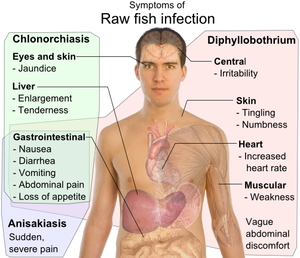
Clonorchiasis
Encyclopedia
Clonorchiasis is an infectious disease
caused by the Chinese liver fluke
, Clonorchis sinensis
.
Clonorchiasis is a known risk factor for the development of cholangiocarcinoma
, a neoplasm of the biliary system.
 Symptoms of opisthorchiasis caused by Opisthorchis viverrini and by Opisthorchis felineus
Symptoms of opisthorchiasis caused by Opisthorchis viverrini and by Opisthorchis felineus
are indistinguishable from clonorchiasis caused by Clonorchis sinensis
, so the disease by these three parasites should be referred as clonorchiasis.
, especially in Korea, Japan, Taiwan, and Southern China. Clonorchiasis has been reported in non endemic areas (including the United States). In such cases, the infection is found in Asian immigrants, or following ingestion of imported, undercooked or pickled freshwater fish containing metacercariae.
Infectious disease
Infectious diseases, also known as communicable diseases, contagious diseases or transmissible diseases comprise clinically evident illness resulting from the infection, presence and growth of pathogenic biological agents in an individual host organism...
caused by the Chinese liver fluke
Liver fluke
Liver flukes are a polyphyletic group of trematodes .Adults of liver flukes are localized in the liver of various mammals, including humans. These flatworms can occur in bile ducts, gallbladder, and liver parenchyma. They feed on blood...
, Clonorchis sinensis
Clonorchis sinensis
Clonorchis sinensis, the Chinese liver fluke, is a human liver fluke in the class Trematoda, Phylum Platyhelminthes. This parasite lives in the liver of humans, and is found mainly in the common bile duct and gall bladder, feeding on bile...
.
Clonorchiasis is a known risk factor for the development of cholangiocarcinoma
Cholangiocarcinoma
Cholangiocarcinoma is a cancer of the bile ducts which drain bile from the liver into the small intestine. Other biliary tract cancers include pancreatic cancer, gallbladder cancer, and cancer of the ampulla of Vater...
, a neoplasm of the biliary system.

Opisthorchis felineus
Opisthorchis felineus, or cat liver fluke is a trematode parasite that infects the liver in mammals. It was first discovered in 1884 in a cat's liver by Sebastiano Rivolta of Italy. In 1891, Russian scientist K.N. Vinogradov found it in a human, and named the parasite a "Siberian liver fluke"...
are indistinguishable from clonorchiasis caused by Clonorchis sinensis
Clonorchis sinensis
Clonorchis sinensis, the Chinese liver fluke, is a human liver fluke in the class Trematoda, Phylum Platyhelminthes. This parasite lives in the liver of humans, and is found mainly in the common bile duct and gall bladder, feeding on bile...
, so the disease by these three parasites should be referred as clonorchiasis.
Background
Clonorchiasis sinensis is a trematode (fluke) which is part of the phylum Platyhelminthes. It is a hermaphroditic fluke that requires two intermediate hosts. The parasitic worm is as long as 10 to 25mm and lives in the bile ducts of the liver. The eggs of the worms are passed through fecal matter which are then ingested by mollusks. One becomes infected by eating undercooked, smoked, pickled or salted freshwater fish. Freshwater fish are a second intermediate host for the parasitic worm. They become infected when the larvae (cercaria) of the worm penetrates the flesh of the fish. The water snail is the first intermediate host in which a miracidium (an embryonated egg discharged in stool) goes through its developmental stages of (sporocyst, rediae and cercariae). Clonorchiasis is endemic in the Far EastFar East
The Far East is an English term mostly describing East Asia and Southeast Asia, with South Asia sometimes also included for economic and cultural reasons.The term came into use in European geopolitical discourse in the 19th century,...
, especially in Korea, Japan, Taiwan, and Southern China. Clonorchiasis has been reported in non endemic areas (including the United States). In such cases, the infection is found in Asian immigrants, or following ingestion of imported, undercooked or pickled freshwater fish containing metacercariae.
External links
- http://www.britannica.com/EBchecked/topic/122073/clonorchiasis

